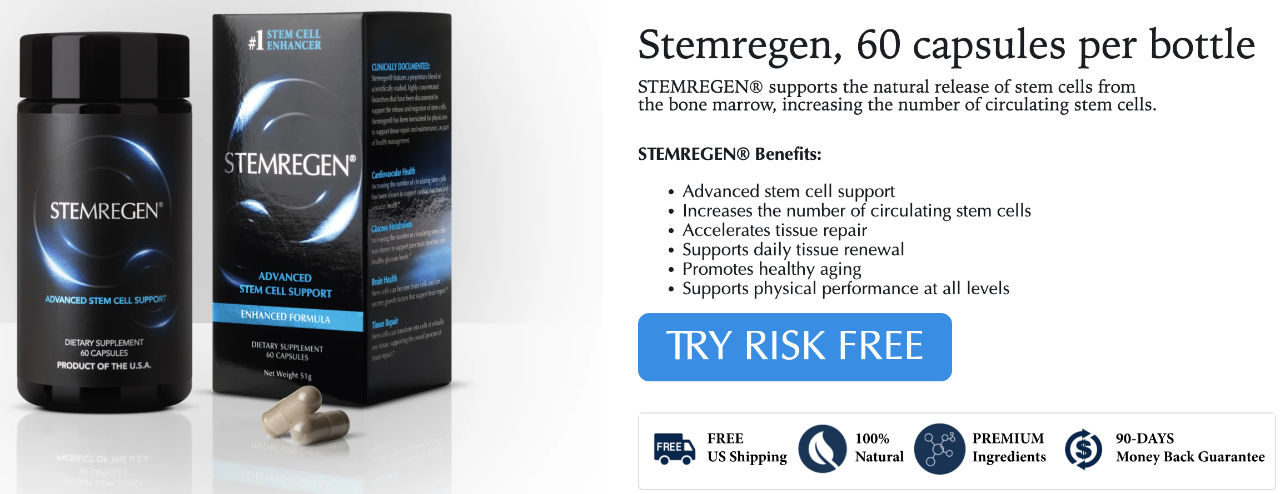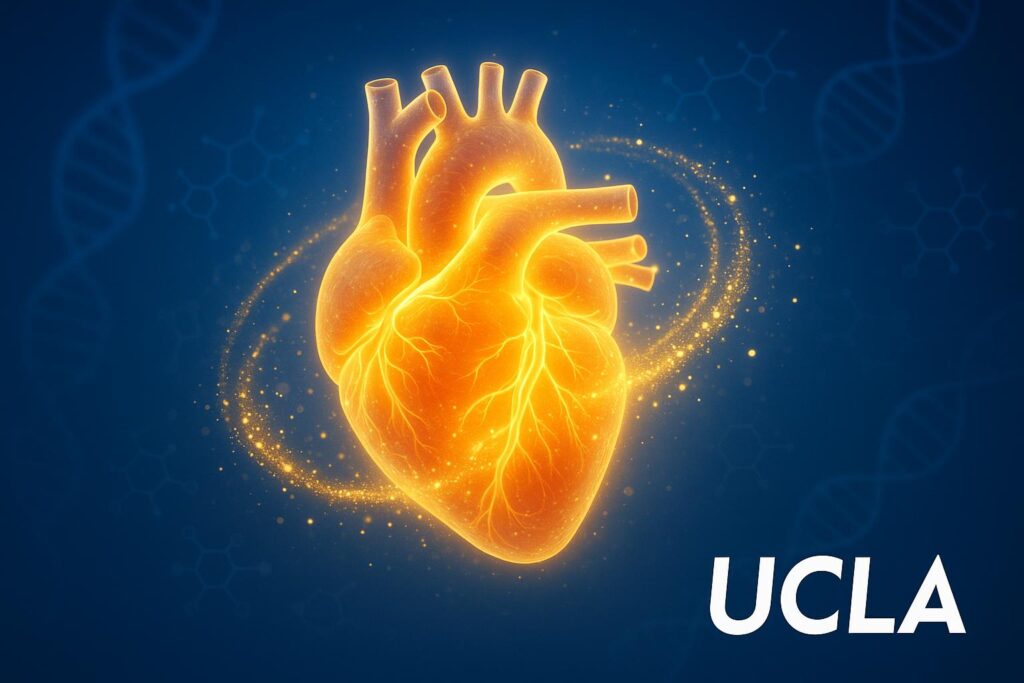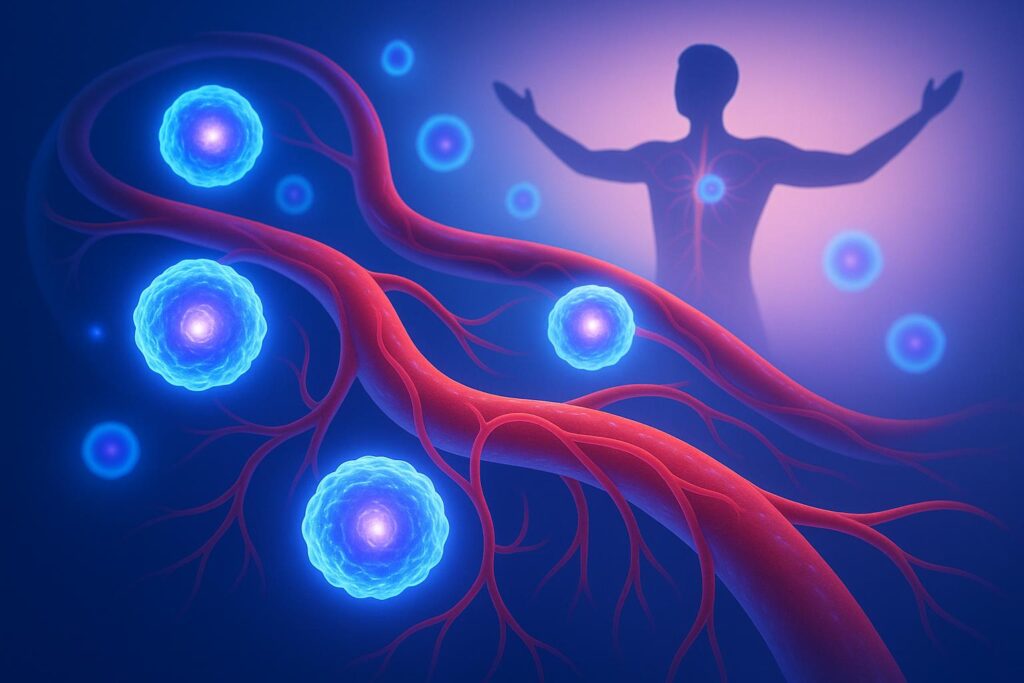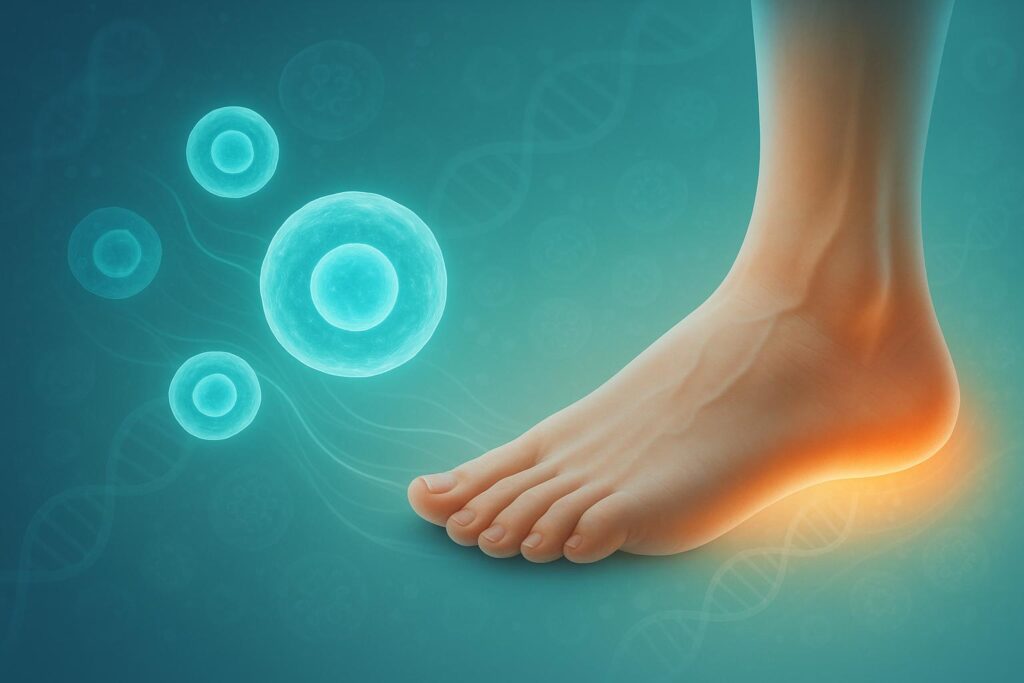Do you pinch your skin and watch it slowly return to place? Have you noticed that cuts and scrapes take longer to heal? Does your skin look dull and tired no matter how much moisturizer you use?
If you’re over 30, you’ve probably noticed your skin doesn’t bounce back like it used to. What once healed quickly now takes weeks. What once looked plump and elastic now appears thin and fragile.
This isn’t just “normal aging.” Skin deterioration accelerates due to a specific biological process that most people never address: stem cell depletion.
Your skin contains specialized stem cells responsible for regeneration, repair, and maintaining that youthful bounce. As these cells decline, your skin loses its ability to renew itself effectively.
The good news? Understanding this process gives you the power to slow it down and even reverse some of the damage.
The Skin Regeneration Crisis
Skin aging isn’t just about wrinkles and age spots. It’s about your skin’s fundamental ability to repair and regenerate itself.
The Numbers Don’t Lie
Skin stem cell decline follows a predictable pattern:
| Age | Stem Cell Activity | Skin Regeneration Rate | Healing Time |
|---|---|---|---|
| 20s | 100% baseline | 28 days | 3-5 days |
| 30s | 75% remaining | 35 days | 5-7 days |
| 40s | 50% remaining | 45 days | 7-10 days |
| 50s | 25% remaining | 60 days | 10-14 days |
| 60s | 15% remaining | 75+ days | 14+ days |
The shocking truth: By age 50, your skin regenerates at less than half the rate it did in your 20s.
What You’re Actually Seeing
Visible signs of stem cell depletion include:
Loss of Elasticity
- Skin doesn’t snap back when pinched
- Sagging around eyes, cheeks, jawline
- Deep expression lines that don’t fade
Slower Healing
- Cuts and scrapes take longer to close
- Acne marks linger for months
- Bruises fade slowly
Texture Changes
- Rough, uneven surface
- Enlarged pores
- Thin, fragile skin
Color Changes
- Dull, lackluster appearance
- Uneven pigmentation
- Age spots and discoloration
The Science of Skin Stem Cells
Skin stem cells are your body’s natural anti-aging system. Understanding how they work reveals why your skin changes over time.
Types of Skin Stem Cells
Epidermal Stem Cells
- Location: Base of epidermis
- Function: Replace surface skin cells
- Regeneration cycle: 28 days (young) to 75+ days (aged)
- Decline rate: 50% by age 50
Hair Follicle Stem Cells
- Location: Hair follicle bulge
- Function: Hair growth and skin repair
- Decline rate: 30% by age 40
- Impact: Thinning hair, slower wound healing
Dermal Stem Cells
- Location: Deep dermis layer
- Function: Collagen and elastin production
- Decline rate: 60% by age 60
- Impact: Loss of firmness and elasticity
The Stem Cell Regeneration Process
Step 1: Activation
- Damage signals activate dormant stem cells
- Growth factors trigger cell division
- New cells begin forming
Step 2: Differentiation
- Stem cells transform into specific cell types
- Keratinocytes for surface protection
- Fibroblasts for collagen production
Step 3: Migration
- New cells move to damaged areas
- Replace old, damaged cells
- Restore tissue function
Step 4: Integration
- New cells integrate with existing tissue
- Restore normal skin function
- Complete the repair process
Why Stem Cells Decline
Intrinsic Aging Factors:
- DNA damage accumulates over time
- Telomere shortening limits cell division
- Mitochondrial dysfunction reduces energy
- Protein aggregation impairs function
External Aging Accelerators:
- UV radiation damages stem cell DNA
- Pollution creates oxidative stress
- Poor nutrition limits repair resources
- Chronic stress elevates cortisol
The Stem Cell-Skin Connection
Stem cell health directly determines skin appearance and function.
Collagen Production Decline
Collagen gives skin its structure and bounce. Stem cells control collagen production.
Collagen Loss by Age:
- Age 25: Peak collagen production
- Age 30: 1% annual decline begins
- Age 40: 10% total loss
- Age 50: 20% total loss
- Age 60: 30% total loss
Stem Cell Impact on Collagen:
- Fewer stem cells = less collagen production
- Damaged stem cells = defective collagen
- Inactive stem cells = collagen breakdown exceeds production
Elastin Network Breakdown
Elastin provides skin’s snap-back ability. Stem cells maintain elastin networks.
Elastin Changes with Age:
- Young skin: Dense, organized elastin fibers
- Aging skin: Fragmented, disorganized fibers
- Result: Loss of elasticity and firmness
Hyaluronic Acid Depletion
Hyaluronic acid holds 1,000 times its weight in water. Stem cells produce this moisture magnet.
Hyaluronic Acid Decline:
- Age 20: 100% baseline
- Age 40: 50% remaining
- Age 60: 25% remaining
- Result: Dry, thin, dehydrated skin
Factors That Accelerate Stem Cell Decline
Modern lifestyle creates perfect conditions for premature skin stem cell aging.
UV Damage: The #1 Skin Ager
UV radiation directly damages skin stem cells:
UVA Rays (95% of UV exposure)
- Penetrate deep into dermis
- Damage stem cell DNA
- Create free radicals
- Accelerate aging by 80%
UVB Rays (5% of UV exposure)
- Damage surface stem cells
- Cause immediate inflammation
- Trigger protective responses
- Lead to long-term damage
UV Protection Strategies:
- Broad-spectrum SPF 30+ daily
- Reapply every 2 hours
- Seek shade during peak hours (10 AM – 4 PM)
- Protective clothing and hats
Lifestyle Factors
Poor Sleep
- Reduces growth hormone production
- Limits stem cell activation
- Impairs repair processes
- Accelerates aging by 30%
Chronic Stress
- Elevates cortisol levels
- Damages stem cell DNA
- Reduces regeneration capacity
- Ages skin 3-5 years prematurely
Poor Nutrition
- Limits building blocks for repair
- Reduces antioxidant protection
- Impairs stem cell function
- Accelerates decline by 40%
Smoking
- Reduces oxygen delivery
- Creates massive oxidative stress
- Damages stem cell DNA
- Ages skin 10-20 years prematurely
How to Restore Skin Stem Cell Function
Skin stem cells can be reactivated and protected with the right approach.
Topical Stem Cell Activators
Plant Stem Cell Extracts
- Apple stem cells: Protect against UV damage
- Grape stem cells: Boost collagen production
- Argan stem cells: Enhance regeneration
- Application: Use serums with 2-5% concentration
Growth Factor Serums
- EGF (Epidermal Growth Factor): Stimulates cell division
- PDGF (Platelet-Derived Growth Factor): Enhances healing
- TGF-β (Transforming Growth Factor): Boosts collagen
- Application: Apply twice daily to clean skin
Peptide Complexes
- Copper peptides: Activate stem cells
- Matrixyl peptides: Stimulate collagen
- Argireline peptides: Reduce muscle contractions
- Application: Use in evening routine
Nutritional Support for Skin Stem Cells
Stem Cell Supporting Nutrients:
| Nutrient | Dosage | Function | Food Sources |
|---|---|---|---|
| Vitamin C | 1,000-2,000mg | Collagen synthesis | Citrus, berries |
| Vitamin E | 400 IU | Antioxidant protection | Nuts, seeds |
| Vitamin A | 10,000 IU | Cell regeneration | Liver, carrots |
| Zinc | 15-30mg | Wound healing | Oysters, meat |
| Selenium | 200mcg | DNA protection | Brazil nuts |
Skin-Specific Supplements:
- Collagen peptides: 10-15g daily
- Hyaluronic acid: 120-240mg daily
- Resveratrol: 500mg daily
- Astaxanthin: 4-8mg daily
Lifestyle Interventions
Sleep Optimization
- 7-9 hours nightly for optimal repair
- Consistent schedule to regulate hormones
- Cool, dark room for deep sleep phases
- Silk pillowcase to reduce friction
Stress Management
- Meditation: 10-20 minutes daily
- Exercise: Moderate intensity, regular
- Breathing exercises: 4-7-8 technique
- Social connection: Reduce isolation stress
Hydration Protocol
- Water intake: Half body weight in ounces
- Electrolyte balance: Add sea salt to water
- Timing: Spread throughout day
- Quality: Filtered water preferred
Advanced Skin Stem Cell Therapies
Professional treatments can dramatically accelerate skin stem cell regeneration.
Microneedling with Growth Factors
Process:
- Create micro-channels in skin
- Apply growth factor serums
- Stimulate natural healing response
- Activate dormant stem cells
Results:
- 30-50% improvement in texture
- 25-40% reduction in fine lines
- Increased collagen production
- Enhanced product absorption
Protocol:
- Frequency: Every 4-6 weeks
- Sessions: 3-6 treatments
- Downtime: 24-48 hours
- Cost: $200-500 per session
Platelet-Rich Plasma (PRP)
Process:
- Extract patient’s blood
- Concentrate growth factors
- Inject into skin
- Stimulate stem cell activation
Benefits:
- Uses body’s own healing factors
- No risk of allergic reaction
- Stimulates natural regeneration
- Long-lasting results
Results Timeline:
- Week 1-2: Initial healing
- Week 3-4: Texture improvement
- Month 2-3: Visible rejuvenation
- Month 6: Peak results
Red Light Therapy
Mechanism:
- 660-850nm wavelength penetration
- Stimulates mitochondrial function
- Increases ATP production
- Activates stem cell metabolism
Protocol:
- Duration: 10-20 minutes daily
- Distance: 6-12 inches from skin
- Frequency: 5-7 days per week
- Results: Visible in 4-8 weeks
The 30-Day Skin Stem Cell Revival Plan
Follow this protocol to reactivate your skin’s regenerative capacity:
Week 1: Foundation Building
Days 1-7: Protect and Prepare
- Start broad-spectrum SPF 30+ daily
- Begin gentle cleansing routine
- Introduce vitamin C serum
- Optimize sleep schedule
Daily Checklist:
- [ ] SPF application (morning)
- [ ] Gentle cleanser (evening)
- [ ] Vitamin C serum (morning)
- [ ] Moisturizer (morning and evening)
- [ ] 7-9 hours sleep
Week 2: Activation Phase
Days 8-14: Stimulate Regeneration
- Add growth factor serum
- Include collagen supplements
- Begin stress management practice
- Increase water intake
Daily Checklist:
- [ ] All Week 1 protocols
- [ ] Growth factor serum (evening)
- [ ] Collagen supplement (10g)
- [ ] 10 minutes meditation
- [ ] 64+ oz water
Week 3: Enhancement Phase
Days 15-21: Accelerate Repair
- Introduce retinol (start 2x/week)
- Add antioxidant supplements
- Include facial massage
- Optimize nutrition
Daily Checklist:
- [ ] All previous protocols
- [ ] Retinol (2x this week)
- [ ] Antioxidant supplements
- [ ] 5-minute facial massage
- [ ] Nutrient-dense meals
Week 4: Integration Phase
Days 22-30: Optimize and Assess
- Increase retinol frequency
- Add professional treatment
- Track improvements
- Plan long-term strategy
Daily Checklist:
- [ ] All established protocols
- [ ] Retinol (3x this week)
- [ ] Professional consultation
- [ ] Progress photos
- [ ] Long-term planning
Measuring Your Progress
Track these metrics to monitor skin stem cell revival:
Visual Assessment (Weekly)
- Elasticity test: Pinch and release timing
- Texture evaluation: Smoothness and evenness
- Hydration check: Plumpness and glow
- Healing speed: Time for minor cuts to close
Professional Assessment (Monthly)
- Dermatoscope analysis: Detailed skin examination
- Hydration measurement: Corneometer readings
- Elasticity testing: Cutometer measurements
- Photography: Standardized lighting and angles
The Bottom Line
Your skin’s inability to bounce back isn’t inevitable aging—it’s stem cell depletion. These specialized cells control every aspect of skin regeneration, from collagen production to wound healing.
The decline starts in your 20s and accelerates with UV exposure, stress, poor nutrition, and lifestyle factors. But stem cells can be reactivated with the right approach.
Start with protection and nutrition. Add targeted treatments that stimulate stem cell function. Consider professional therapies for accelerated results.
Consistency is key. Skin stem cell revival takes time, but the results are worth it. Your skin can regain much of its youthful bounce and resilience.
The fountain of youth isn’t a myth—it’s your stem cells. Give them what they need, and watch your skin transform.
This article provides educational information about skin aging and stem cell function. Always consult qualified dermatologists or healthcare providers before starting new skincare treatments, especially if you have sensitive skin or medical conditions.



